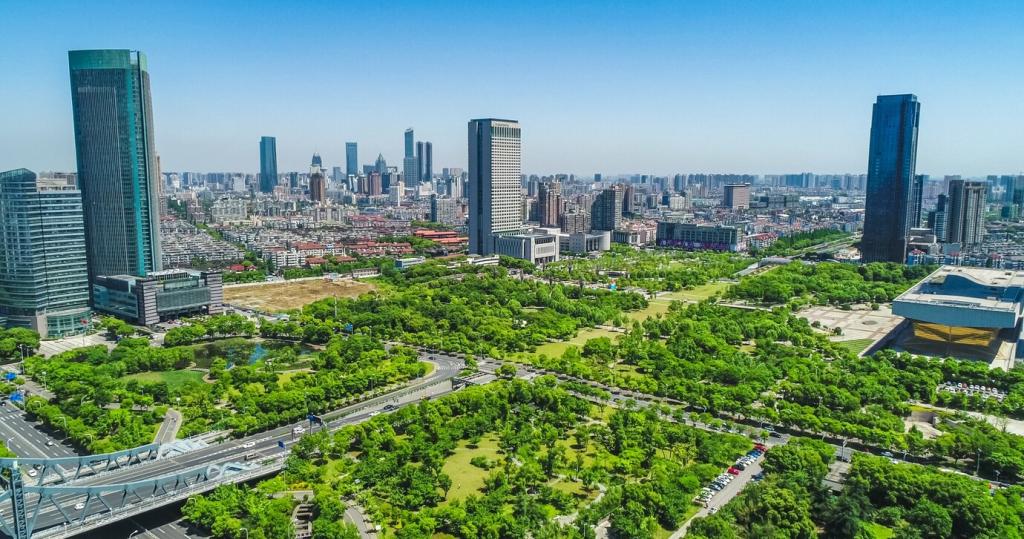
Renewable Energy Integration in City Planning
Renewable energy integration involves incorporating sources like solar, wind, and geothermal into the fabric of urban environments. With growing awareness of climate change and the necessity for sustainable urban growth, city planners are increasingly prioritizing energy systems that minimize carbon emissions and support resilient, healthy communities. The proactive inclusion of renewable energy in city planning not only reduces environmental impact but also offers long-term economic benefits, energy independence, and an improved quality of urban life. Through thoughtful design and forward-thinking strategies, cities worldwide can lead the way toward a clean-energy future.
Urban Infrastructure and Renewable Technologies
Rooftop Solar Implementation
Rooftop solar panels have emerged as a practical solution for urban renewable energy. By converting existing building surfaces into decentralized power plants, cities can harness significant amounts of clean electricity without requiring additional land. Planners determine solar suitability by analyzing sun exposure, structural integrity, and proximity to existing grid infrastructure. Incentive programs, regulations, and awareness campaigns can help facilitate widespread adoption. Ultimately, rooftop solar accelerates the urban transition to clean energy and empowers residents and businesses to participate in sustainability efforts, directly reducing the reliance on fossil fuels.


Wind Energy in Urban Landscapes
Urban wind energy integration presents unique opportunities and challenges. Smaller-scale wind turbines can be installed on taller buildings or within public spaces, capturing wind resources often overlooked in downtown cores. Planners need to carefully assess site-specific wind patterns to ensure effective performance and avoid potential issues such as noise or aesthetic impact. Properly executed, urban wind installations can generate supplemental electricity and reduce grid dependency, adding a resilient layer to urban energy supply. Collaboration between engineers, urban designers, and communities is essential to ensure success.
Policy Frameworks Supporting Renewable Adoption
Regulatory Incentives and Mandates
Urban policies often incorporate a blend of incentives and mandates to accelerate renewable adoption. Incentives might include tax breaks, rebates, or fast-track permitting for buildings with integrated renewables. Meanwhile, mandates could require new developments to meet strict energy standards or include a certain percentage of on-site renewable generation. The balance of incentives and mandates guides industry behavior, ensures compliance, and motivates innovation in sustainable design, pushing cities toward ambitious energy transition goals while providing clear benefits for early adopters.
Streamlining Permits and Approvals
The process of securing permits and approvals can be a significant hurdle for renewable installation, deterring homeowners and businesses from pursuing clean energy projects. By streamlining these processes, local governments remove unnecessary barriers and foster a more dynamic energy market. Digital submission platforms, standardized application requirements, and clear timelines make it far easier to deploy rooftop solar, wind, and geothermal projects citywide. Effective streamlining not only accelerates renewable integration but also signals a municipality’s commitment to innovation and sustainability.
Urban Renewable Energy Targets
Clearly defined renewable energy targets create tangible goals for cities to work toward. These targets may be outlined in comprehensive climate action plans or set as part of broader urban sustainability initiatives. Setting ambitious yet achievable renewable energy targets motivates consistent action across multiple city departments and stakeholders. Tracking progress toward these goals encourages accountability and adaptation of strategies as needed. This results-oriented approach facilitates the steady transition to a clean energy urban framework, helping cities meet their environmental commitments.
Community Engagement and Equity in Energy Planning
Public Participation and Stakeholder Involvement
Involving the public in the city planning process leads to more effective and widely accepted outcomes. Public forums, workshops, and participatory design sessions empower stakeholders to contribute ideas and voice concerns about renewable integration. Such engagement fosters transparency, builds community support, and can highlight local priorities or cultural sensitivities that might otherwise be overlooked. By establishing open lines of communication between planners and residents, cities can create tailored renewable solutions that resonate more closely with the people who use and inhabit those spaces.
Addressing Energy Equity and Accessibility
Historically underserved communities often face barriers to accessing renewable energy, such as upfront costs, lack of information, or inadequate infrastructure. Addressing these disparities is vital for a just energy transition. Strategies may include subsidized installation programs, targeted outreach, and partnerships with local nonprofits to ensure everyone can benefit from cleaner power. Equitable planning also means evaluating the siting of renewable projects to avoid concentrating resources or potential nuisances in already disadvantaged areas. An inclusive approach helps cities remedy past inequities and deliver the promise of the energy transition to all residents.
Workforce Development and Local Benefits
Renewable integration creates opportunities for job growth and local economic development. By investing in workforce training programs and prioritizing community-based hiring, cities can ensure that energy transitions provide tangible benefits to residents. Collaborations with educational institutions, unions, and industry partners help build a skilled workforce equipped to install, maintain, and innovate renewable systems. Special attention to training marginalized or displaced workers fosters long-term economic resilience, making the renewable energy sector a driver for inclusive urban prosperity alongside environmental sustainability.

